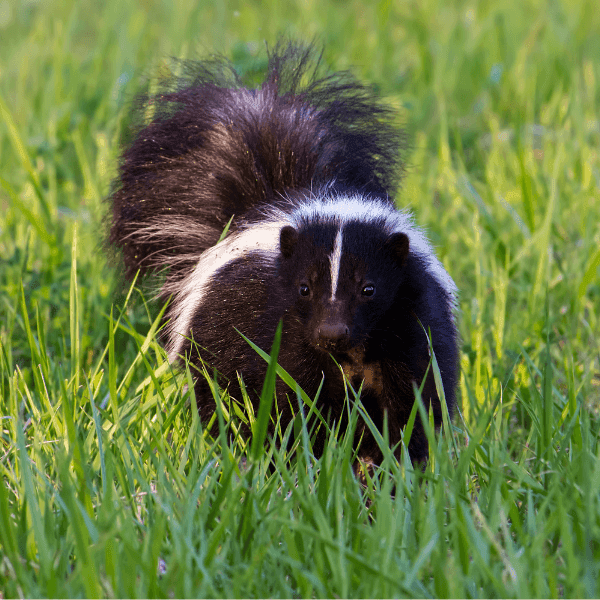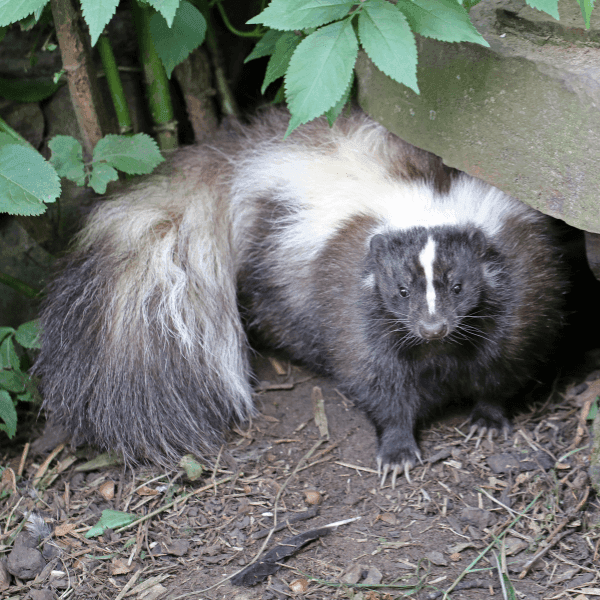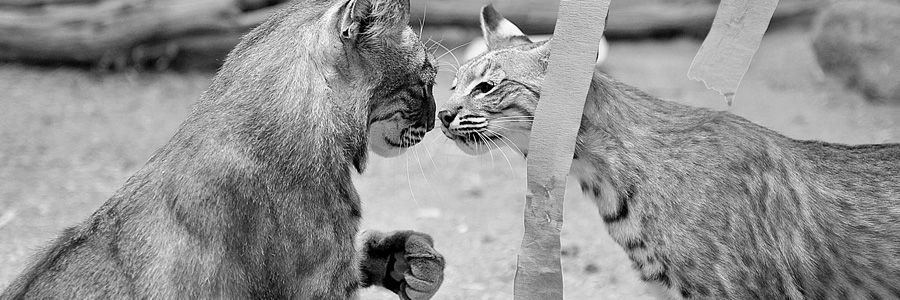SKUNK

Hooded Skunk, Mephitis macroura
- Habitat: Desert or dune, savanna or grassland, forest, rainforest, and scrub forest
- Status: Least concern
- Population Trend: Increasing
- Diet: Birds, mammals, amphibians, fish, eggs, carrion, insects, terrestrial non-insect arthropods, terrestrial worms, seeds, grains, nuts, and fruit
- Weight: 1 - 5 lbs.
- Size: 22" - 31" long; 11" - 13" tall
- Lifespan: Up to 3 years in the wild; up to 7 years in human care
- Interesting Facts:
- Hooded skunks are true ground dwellers and can't climb at all.
- The only true predators of Hooded skunks are Great horned owls as they have a very poor sense of smell and don't feel the odor powerful musk sprayed by skunks.
- Other common names for the Hooded skunk include: mofeta rayada (Spanish), moufette à capuchon (French), pay (Maya), southern skunk, white-sided skunk, and zorrillo.
North American Hog-Nosed Skunk, Conepatus leuconotus
- Habitat: Savanna, grassland, forest, and mountains
- Status: Least concern
- Population Trend: Decreasing
- Diet: Terrestrial vertebrates, non-insect arthropods, mammals, reptiles, insect, fruit, and flowers
- Weight: 2 - 3 lbs.
- Size: 21" - 22" long; 22" - 41" tall
- Lifespan: 3 - 4 years in the wild; up to 14 years in human care
- Wild population in Arizona: Unspecified
- Interesting Facts:
- In Texas, the American hog-nosed skunk is commonly known as the Rooter skunk for its habit of rooting and overturning rocks and debris in search of food.
- The American hog-nosed skunk is sometimes considered a pest by crop farmers due to their rooting habits, however, in fact, these animals generally prefer insects to agricultural plants.
- Skunks are not afraid of snake bites as they are immune to snake venom.
Striped Skunk, Mephitis mephitis
- Habitat: Woodlands, forests, wooded ravines and grassy plains
- Status: Least Concern
- Population Trend: Stable
- Diet: Birds, mammals, amphibians, reptiles, fish, eggs, carrion, insects, terrestrial non-insect arthropods, terrestrial worms, and aquatic crustaceans
- Weight: 2 - 14 lbs.
- Size: 18" - 32" long; 20" - 30" tall
- Lifespan: 1 - 7 years in captivity; up to 10 years in human care
- Wild population in Arizona: Unspecified
- Interesting Facts:
- Striped Skunk gets its name from the Latin word “mephit” meaning “bad odor”.
- Discharges a yellowish, oily, nauseating, sulfur-alcohol compound from two anal scent glands as an intimidation tool.
- The striped skunk is able to direct the stream of musk up to 10 feet and the smell may carry up to one and a half miles downward.
Western Spotted Skunk, Spilogale gracilis
- Habitat: Rocky bluffs and brush-bordered canyon stream beds
- Status: Least concern
- Population Trend: Decreasing
- Diet: Eggs, young rabbits, fruit, berries, mice, voles, roots, and even arthropods such as grasshoppers
- Weight: 1 - 3 lbs.
- Size: 16" - 17" tall; 35" - 45" long
- Lifespan: 1 - 3 years in the wild; up to 6 years in human care
- Wild population in Arizona: Unspecified
- Interesting Facts:
- Western spotted skunks can swim but will do that only when their life is in danger.
- Western spotted skunks can cause problems in rural areas, as they will make dens on private property and in the attics of homes. They also often steal eggs from farmers.
- The Western spotted skunk is one of many species that can adapt within the expansion of human civilization and remain neither endangered nor threatened.



